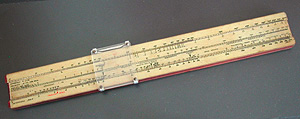 |
|
|
|

|

|
Homemade hydrological slide rule |
|
|
|
|
When I saw this one on eBay, I just knew I had to get it: I love unusual devices, and this one was as unusual as they get. Made of rough wood, with the scales hand drawn on paper strips in India ink, glued on and protected by what looks like some sort of cellophane coating: this is an old 12-inch slide rule made entirely by hand with exquisite attention to detail. |
 Click photo to enlarge |
|
|
|
Now, it was not unheard of for a hobbyist to construct a slide rule at home; but those would be made of cardboard, with a couple of log scales; there were articles in the DIY magazines on how to do it. The rule before us here, however, is at the exact opposite end of the complexity scale. It is a sophisticated tool with numerous esoteric scales aimed at a specific profession. What that profession was remained a mystery; the seller told me he had bought it in Holland from a guy who conjectured that it may have to do with crop spraying; for my part, I suspected rainwater management. Click the photo below to see the scales (including one in the well under the slide) and make your own guess... | |
|
|
|
 Click photo to enlarge |
|
|
|
|
And there the riddle remained for some time, until I discovered that
Ron Manley,
an experienced collector, is a Hydrologist! I sent him a photo and
he asserted that this rule is used for urban drainage design. The
units (e.g. "CFM per Acre") suggest that it came from the US. The
"impervious coefficients" are used to calculate what proportion of a
drainage area is impermeable; hence labels such as "open spaces" and
"residential-house density", which refer to different types of urban
development. The sub-scale (5, 6,...,14) refers to the number of
houses per acre, so, for example, 10 houses per acre is equivalent
to having 0.38 of the drainage area impermeable. The scales of
Gradient and Velocity are used for sewer design; other scales
calculate the water runoff for different conditions of rainstorm. Ron also tells me that he never saw a similar commercial device; evidently this is not a knock-off, but an original creation made by an ingenious individual. So why did the creator of this tool go to all this trouble? We may never know with certainty. Perhaps he developed it for his own use; or perhaps this is a prototype he had built, in preparation for a commercial product that never came to be. Whatever his motive, his handiwork marks him as a person of knowledge, skill and the ability to improvise -– in other words, a quintessential engineer. I am honored that his one-of-a-kind product rests in my collection!
Exhibit provenance: More info: If you know anything about this slide rule, please drop me a line! |
|
|
|
|
|
|
|
|
|
Home | HOC | Fractals | Miscellany | About | Contact Copyright © 2005 N. Zeldes. All rights reserved. |
|